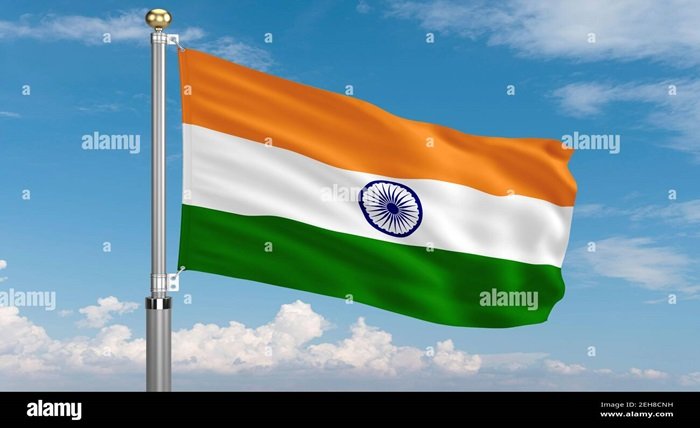Indian Flag Waver: Symbolism, Pride, and the Stories Behind the Iconic Gesture

The “Indian flag waver” is more than just a person waving the national flag; it’s a symbol of unity, pride, and patriotism. The act of waving the Indian flag goes back to the time of the independence movement, where the tricolor represented the collective hopes and dreams of millions fighting for freedom. The Indian flag waver during protests, parades, and national events embodies a deep-seated patriotism that resonates with every citizen.
From the pre-independence rallies to the annual Republic Day parades, the “Indian flag waver” has played an essential role in expressing the emotions of the masses. The act of waving the Indian flag during significant moments in history symbolizes resilience, hope, and an undying spirit for freedom. As a result, the image of a proud flag waver has become a strong visual representation of India’s struggle, its victories, and its aspirations.
The Symbolism Behind the Indian Flag Waver
The flag waver symbolizes patriotism, solidarity, and national pride. Each wave of the tricolor represents the sacrifices made by countless freedom fighters and the dreams of an entire nation. The flag itself, consisting of saffron, white, green, and the Ashoka Chakra, embodies the values of courage, peace, prosperity, and righteousness.
For the Indian flag waver, each color holds significance. Saffron represents the strength and courage of the country, while white stands for truth and peace. Green signifies fertility, growth, and prosperity, and the Ashoka Chakra symbolizes the eternal wheel of law. Together, these elements remind us that every Indian flag waver carries not just a piece of fabric, but the weight of the nation’s values and dreams.
The Role of Indian Flag Wavers During National Celebrations
The “Indian flag waver” takes center stage during national celebrations such as Republic Day and Independence Day. During these events, flag wavers are seen in every part of the country, from government-organized parades to community events, each person showcasing their pride in being Indian. The sight of an Indian flag waver during these events fills the atmosphere with a sense of unity and shared patriotism.
Whether it’s in the hands of soldiers marching on Rajpath or a child waving the flag at a school celebration, the role of the Indian flag waver is pivotal in showcasing the love and respect people have for their country. It is through these celebrations that the spirit of unity, courage, and national pride shines through, and the “Indian flag waver” becomes a symbol of hope and inspiration for future generations.
Indian Flag Waver During Protests and Movements
The “Indian flag waver” has also been a powerful symbol during protests and social movements. The Indian flag has often been used by protestors to demand justice, equality, and change, making the Indian flag waver a symbol of the voice of the people. Whether it is environmental protests, farmers’ movements, or civil rights marches, the Indian flag waver signifies a call for a better future.
Holding the national flag during protests symbolizes that the demands being made are not just personal, but are for the good of the nation. The Indian flag waver becomes a representation of solidarity and the people’s desire for a better society. The image of a lone flag waver in a sea of protestors has a profound emotional impact, invoking a sense of patriotism and collective action.
The Emotional Impact of the Indian Flag Waver
The sight of an “Indian flag waver” evokes powerful emotions in every Indian. There is something deeply moving about seeing the tricolor being waved with pride, especially during moments of national importance. The image of the Indian flag waver brings feelings of nostalgia, pride, and a connection to the struggles and victories that define the country.
The emotional impact is particularly strong during sporting events when the Indian flag waver stands tall in the audience, cheering for the country. Moments like these unite people across different regions, religions, and cultures, as everyone comes together to support the nation. The Indian flag waver becomes a symbol of shared pride and national spirit that transcends individual differences.
The Role of Indian Flag Wavers in Sports Events
The “Indian flag waver” plays a prominent role in international sports events, representing the pride and support of millions of Indians. Whether it’s cricket, hockey, or the Olympics, the sight of the tricolor being waved in the stands is a source of motivation for athletes and a symbol of support from the nation.
The Indian flag waver at these events often becomes an icon, with cameras capturing their enthusiasm and pride. The energy and passion of these flag wavers have an infectious effect, uplifting not only the players but also the entire audience watching from home. It is through these passionate displays that the Indian flag waver becomes a representative of national unity and pride, showcasing the love Indians have for their country and its athletes.
The Art and Craft of Indian Flag Waving
The act of being an “Indian flag waver” is often seen as an art form during parades and ceremonies. The way the flag is waved, with respect and precision, is crucial in representing the pride of the nation. There are certain protocols and guidelines that must be followed to ensure that the flag is treated with dignity.
For the Indian flag waver, understanding the proper way to hold and wave the flag is essential. The flag must never touch the ground, and it should always be held high, symbolizing the country’s pride and honor. During official events, the Indian flag waver follows specific movements to ensure that the flag is displayed with grace and respect, emphasizing the importance of the national symbol.
The Impact of Indian Flag Wavers on Social Media
In recent years, the “Indian flag waver” has gained significant visibility on social media platforms. During national events or protests, images and videos of flag wavers go viral, spreading the message of patriotism and unity across the country. Social media has amplified the impact of the Indian flag waver, making it easier for people to connect with the emotions behind the gesture.
Platforms like Instagram, Twitter, and TikTok have countless videos of Indian flag wavers, each one representing a moment of pride and celebration. The Indian flag waver has become a powerful visual symbol that resonates with people, encouraging them to express their love for the country. The use of hashtags and sharing of content has allowed the message of unity and patriotism to reach a wider audience, inspiring others to take part in the celebrations.
The Significance of the Indian Flag Waver for Future Generations
The “Indian flag waver” holds great significance for future generations, serving as a reminder of the country’s history, values, and aspirations. The act of waving the flag is more than just a gesture; it is a way to pass on the values of patriotism, unity, and respect for the nation to younger generations.
For children and young adults, seeing an Indian flag waver during national events instills a sense of pride and responsibility. It encourages them to learn more about the country’s history and the sacrifices made by those who fought for freedom. The Indian flag waver becomes a symbol of inspiration, motivating future generations to uphold the values of the nation and work towards its progress.
Conclusion
The “Indian flag waver” is a powerful symbol of pride, unity, and patriotism. Whether during national celebrations, protests, sporting events, or on social media, the act of waving the tricolor embodies the spirit of the nation. The Indian flag waver represents the collective emotions of millions, serving as a reminder of the country’s history, values, and aspirations.
Through the symbolism of the colors, the cultural significance, and the emotional impact, the Indian flag waver continues to inspire and unite people across the country. It is a gesture that carries the weight of a nation’s pride and hopes for the future, reminding every Indian of their duty to uphold the values represented by the tricolor.
FAQs
1. What does an Indian flag waver represent?
An Indian flag waver represents patriotism, unity, and pride in the country. The act of waving the flag symbolizes the collective emotions of the nation.
2. Why is the Indian flag waver important during national events?
The Indian flag waver is important during national events as it showcases the pride and love people have for their country. It symbolizes unity and shared patriotism.
3. How has social media impacted the role of the Indian flag waver?
Social media has amplified the impact of the Indian flag waver, making it easier for people to share moments of pride and patriotism, and connect with others across the country.
4. What is the significance of the colors in the Indian flag for a flag waver?
The colors in the Indian flag represent courage (saffron), peace (white), prosperity (green), and the Ashoka Chakra symbolizes righteousness. These values are embodied by the Indian flag waver.
5. How does the Indian flag waver inspire future generations?
The Indian flag waver inspires future generations by instilling a sense of pride, responsibility, and respect for the country’s history and values, encouraging them to work towards the nation’s progress.



